|
Related Articles:
Puffers in General,
Puffer Care and Information, True Puffers, Freshwater Puffers,
Burrfishes/Porcupinefishes,
Tobies/Sharpnose
Puffers, Pufferfish Dentistry By Kelly Jedlicki and Anthony Calfo, Puffer Care and Information
by John (Magnus) Champlin, Things That My Puffers
Have Told Me by Justin Petrey,
Related FAQs: Boxfishes, Boxfishes 2, Boxfish Identification, Boxfish Behavior, Boxfish Compatibility, Boxfish Selection, Boxfish Systems, Boxfish Feeding, Boxfish Disease, Boxfish Reproduction, Puffers in General, Puffer Identification, Puffer Behavior, Puffer Compatibility, Puffer Selection, Puffer Systems, Puffer Feeding, Puffer Disease, Puffer Dentistry, Puffer
Reproduction, True Puffers,
Freshwater to
Brackish Puffers, Burrfishes/Porcupinefishes, Tobies/Sharpnose Puffers, Marine Environmental Disease
1,
/The Conscientious Marine
Aquarist
The Puffers Called Box-, Cowfishes,
family Ostraciidae, part 4
To: part 1,
part 2, part 3,
|
|
|
by Bob Fenner |
|
|
Ostracion solorensis Bleeker 1852, the
Reticulate Boxfish. Indo-Australian. To four inches in length. A
great beauty and good choice for home aquarists. More and more
available. A photo of a female Gili Air, Lombok, Indonesia, and
male in S. Sulawesi.
|
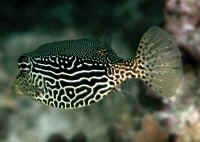 %20male.JPG)
|
Bigger PIX:
The images in this table are linked to large
(desktop size) copies. Click on "framed" images to go to
the larger size. |
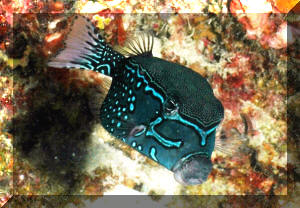
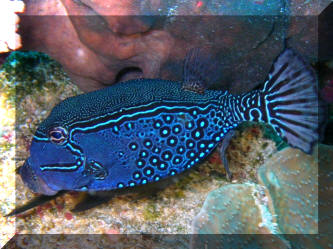 %20MD.JPG) |
|
Ostracion trachys Randall 1975, the
Roughskin Trunkfish. Western Indian Ocean: Mauritius. To four
inches in length.
|
No pic
|
|
Ostracion whitleyi Fowler 1931,
Whitley's Boxfish. Central to western Pacific. Males found
more westward only. To six inches total length. At right is a
female (and male!) in Hawaiian waters, where males are
exceedingly rare. Below, a female and male in Nuka Hiva,
Polynesia where both sexes are much more common. Note the
differences in color, markings between the females of Hawai'i
and the Marquesas.
|
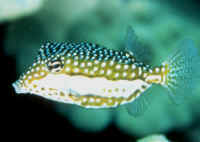 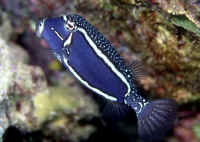
|
|
Paracanthostracion lindsayi (Phillips
1932). Southwestern Pacific: New Zealand.
|
No pic
|
|
Polyplacapros tyleri Fuji & Uyeno 1979.
Southwest Pacific, New Zealand and east Australia.
|
No pic
|
Bigger PIX:
The images in this table are linked to
large (desktop size) copies. Click on "framed" images to
go to the larger size. |
| |
|
Tetrosomus concatenatus (Bloch 1785), the
Triangular Boxfish. Indo-west Pacific. To twelve inches.
|
No pic
|
|
Tetrosomus gibbosus (Linnaeus 1758), the
Humpback Turretfish. Indo-Pacific, Red Sea, east African coast.
To twelve inches in length. Here's one off of Na'ama Bay
in Sharm, Egypt's Red Sea.
|
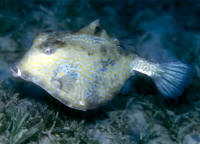
|
Bigger PIX:
The images in this table are linked to large (desktop size) copies.
Click on "framed" images to go to the larger size. |
|
.JPG)
.JPG)
|
|
Tetrosomus reipublicae (Ogilby 1913), the
Smallspine Turretfish. Indo-west Pacific, along east African
coast. To twelve inches in length.
|
No pic
|
Deep/Coldwater Boxfishes: The Family Aracanidae or
Subfamily Aracaninae: Some folks split off these genera, species on
the basis of their carapace being open behind their dorsal and anal
fins, and some other discernible external traits. The seven genera, 13
species rarely make it into the trade, but a few (below) are imported
from where they are most commonly found (Australia).
|
Anoplocapros amygdaloides (Bleeker 1863),
the Western Smooth Boxfish. Southeastern Indian Ocean:
Australia's west and south coasts. To one foot in length.
|
No pic
|
|
Anoplocapros inermis Fraser-Brunner 1941,
the Eastern Smooth Boxfish. Southwestern Pacific:
Australia's eastern coast. To fourteen inches length in the
wild.
|
No pic
|
|
Anoplocapros lenticularis (Richardson
1841), the White-Barred Boxfish. Southeastern Indian Ocean:
Australia's west coast. To thirteen inches in length. This
one in captivity is about four inches. Typical for aquarium use
import.
|
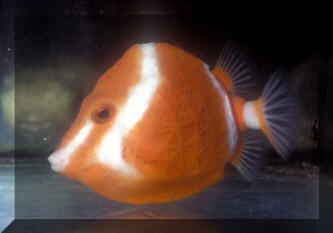
|
|
Anoplocapros robustus (Fraser-Brunner
1941), the Chubby Basketfish. West Pacific. To nine inches.
|
No pic
|
|
Aracana aurita (Shaw 1798), the Striped
Cowfish. Indo-west Pacific. To eight inches. Aquarium images of
juvenile and adult at right and an intermediate individual
below.
|
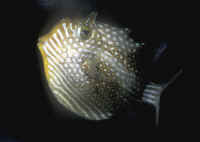 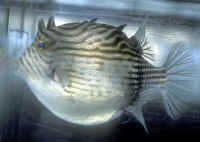
|
Bigger PIX:
The images in this table are linked to large (desktop size) copies.
Click on "framed" images to go to the larger size. |
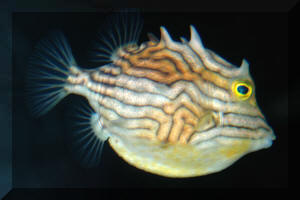 |
|
Aracana ornata (Gray 1838), the Ornate
Cowfish. Southeastern Indian Ocean. To six inches in length.
|
No pic
|
|
Caprichthys gymnura McCulloch & Waite
1915, the Rigid Boxfish. Southeastern Indian Ocean. To four
inches.
|
No pic
|
|
Capropygia unistriata (Kaup 1855), the
Black-Banded Pygmy Boxfish. Southeastern Indian Ocean. To five
inches.
|
No pic
|
|
Kentrocapros aculeatus (Houttuyn 1782).
Western north Pacific: South China Sea. To five inches in
length.
|
No pic
|
|
Kentrocapros eco (Phillips 1932).
Southwestern Pacific: New Zealand. To four inches.
|
No pic
|
| Kentocapros flavofasciatus
(Kamohara 1938). Western North Pacific and New Caledonia
(antitropical in distribution). To five inches in
length. |
No pic
|
|
Kentrocapros rosapinto (Smith 1949), the
Basketfish. Western Indian Ocean. To about five inches in
length.
|
No pic
|
And further regarding the keeping of ostraciids; they
have not had a good record of success with marine aquarists, mainly
related to diet or the lack of it. These fishes need food, green AND
meaty on a regular basis; most are lost to outright starvation.
Especially on first arrival, or when you acquire them, it is critical
that the specimen begin feeding. Please see the notes under
foods/feeding below.
Bibliography/Further Reading:
Debelius, Helmut. Undated. Pufferfish in the marine
aquarium. Aquarium Digest International #27.
Debelius, Helmut. Undated. Boxfish- those fascinating
marine oddities. Aquarium Digest International #36.
Edmonds, Les. 1989. Boxfishes-armor in the aquarium. TFH
7/89.
Fong, Jack. 1994. The ten most amusing Boxfishes. TFH
8/94.
Lobel, Philip S. 1985. Spawning behavior of the spotted
trunkfish, Ostracion meleagris. FAMA 8/85.
Michael, Scott W. 1997. The puffers; unique in many
ways. AFM 8/97.
Michael, Scott W. 1998. Swimming boxes. Boxfish are
interesting to keep, but choose their tankmates carefully to avoid
disaster. AFM 3/98.
Nelson, Joseph S. 1994. Fishes of the World, 3d ed. John
Wiley & Sons, NY.
Pyle, Richard L. 1989. Whitley's boxfish,
Ostracion whitleyi Fowler. FAMA 7/89.
Quinn, John R. 1986. Puffers & friends; a look at
the pros and cons of keeping the popular puffers. TFH 5/86.
To: part 1,
part 2, part 3,
|
|

